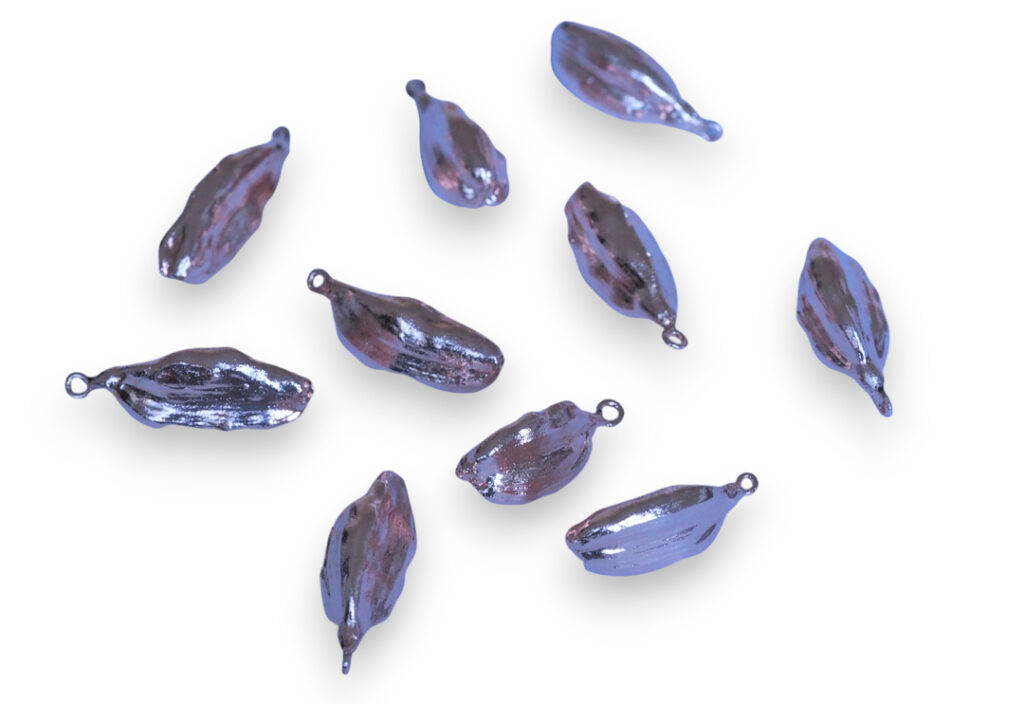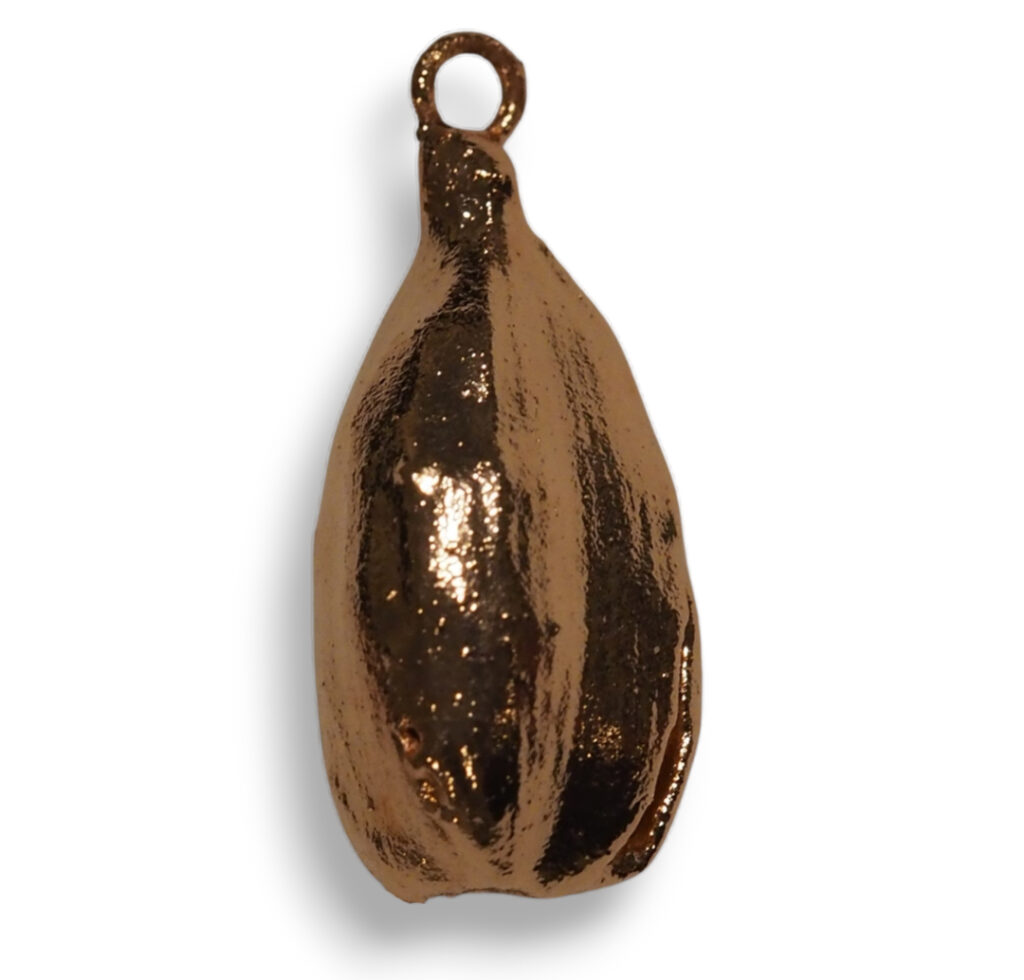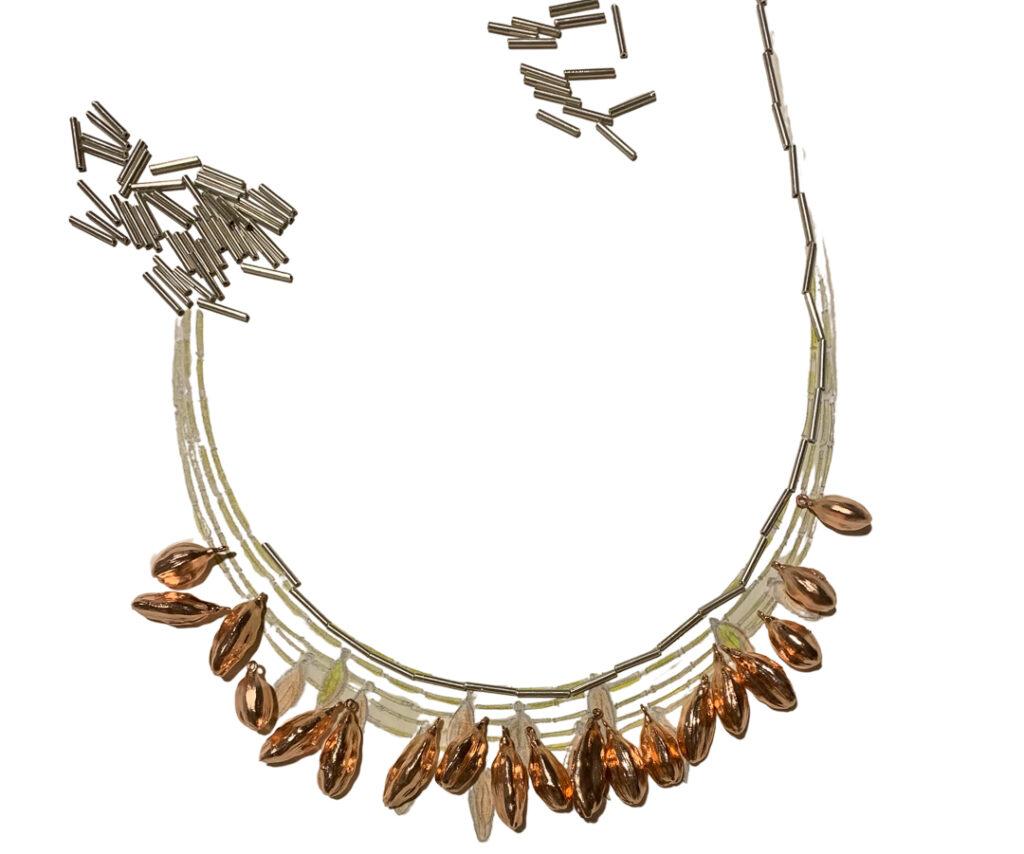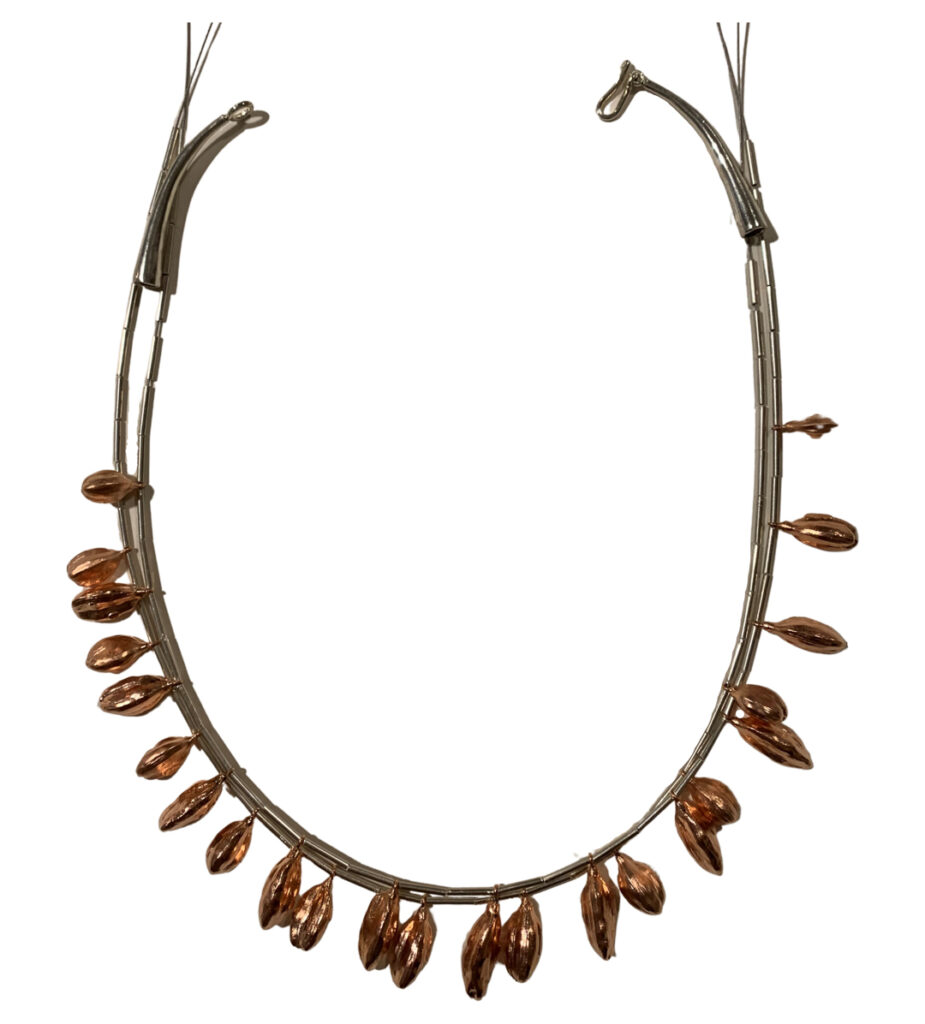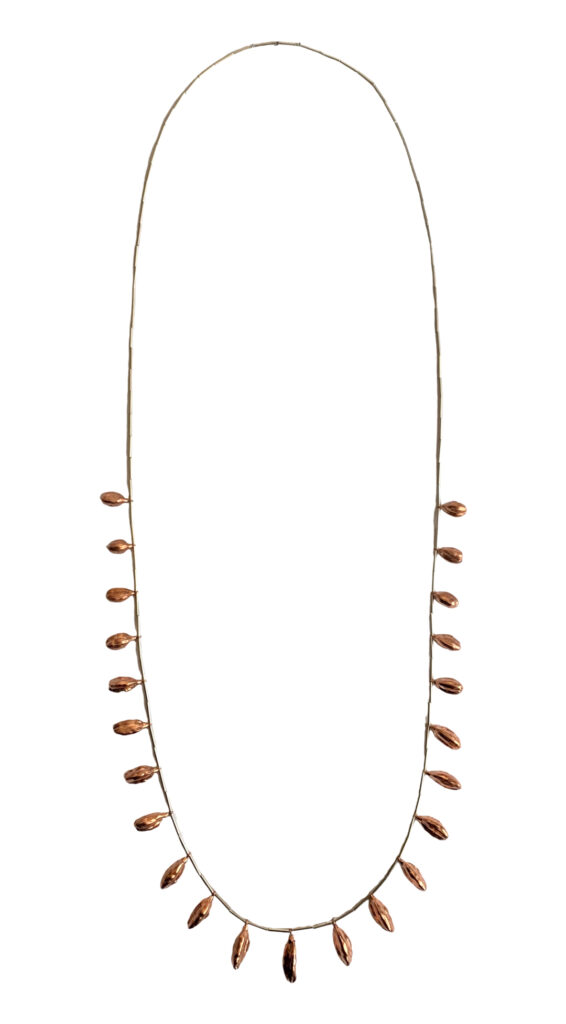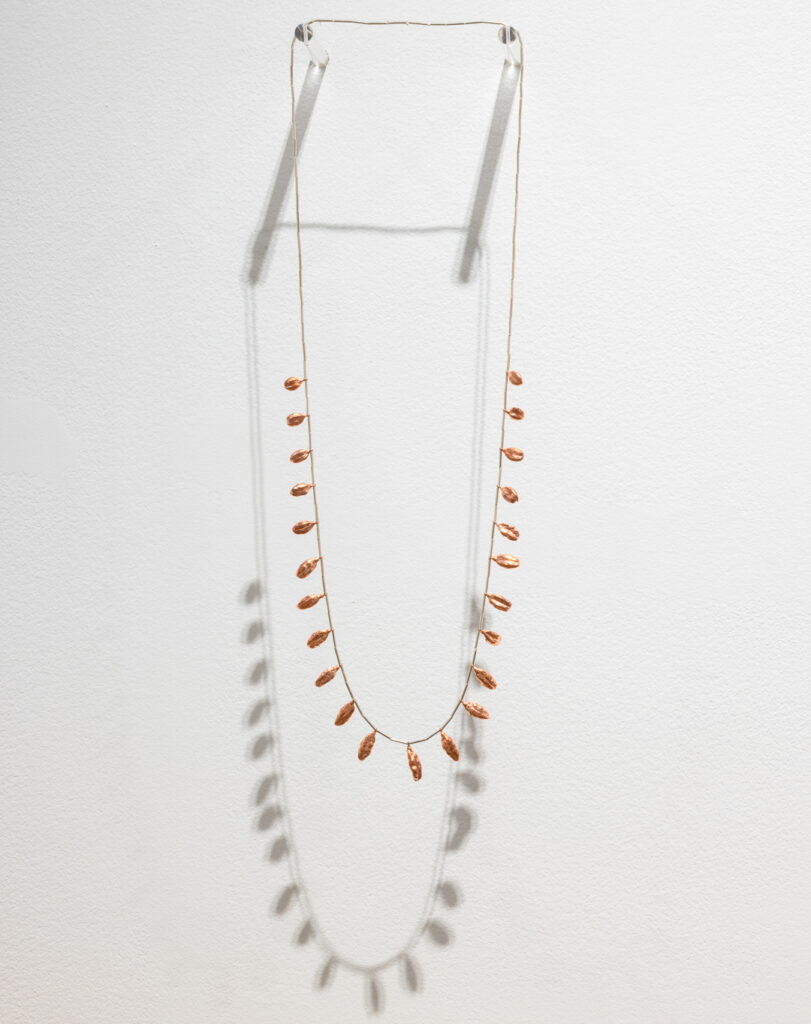
Inoka Samarasekara, Amid and In-between, 2022, The Tangled Jewelled Maze, UNSW Galleries, Copper electroformed cardamom pendants, silver tube beads, photo: Jacquie Manning
Through the process of electroforming, Inoka Samarasekara has been able to embody the smell of Sri Lanka into her jewellery.
In recent times, the forces of globalization have accelerated migration and the emergence of new diasporas worldwide. A diaspora results from a process of displacement and relocation of a “national population in a transnational setting” (Rathod, 2013, p. 116). The Sri Lankan diaspora, for instance, experienced significant growth following the nation’s declaration of independence in 1948. This led to the mass migration of diverse Sri Lankan communities, resulting in the creation of a varied, heterogeneous, and intricate diaspora that includes Sinhalese, Tamils, Muslims, and Burghers.
The migration of Sri Lankans to Australia has a rich historical background that dates back to the British colonial period. In the contemporary context, the Sri Lankan diaspora constitutes the sixth-largest Asian community in Australia (Lokuge, 2020) and the thirteenth-largest overseas-born community (Hugo & Dissanayake, 2017). According to the 2016 census, there were 109,849 individuals born in Sri Lanka residing in Australia (Sri Lanka-born Community Information Summary, 2018).
Narratives of diaspora are imbued with a range of emotions that reflect the “in-between” life experienced by migrants, encompassing feelings of bewilderment, confusion, and homesickness (Rathod, 2013, p. 118). These narratives often intertwine with nostalgic yearnings for the past and idealized visions of the homeland. Nostalgia, in this context, serves as a way to preserve and cherish moments of the past, carefully curated through selective forgetting, distorting, and reorganizing memories (Phillips, 1985, p. 66, as cited in Hutcheon & Valdés, 2000, p. 20). Jasvant V. Rathod, a postcolonial theorist, emphasizes that these memories of the homeland are often fragmentary and partial, fueling a profound longing to return to the ‘lost origin’ of the imagined homeland (Rathod, 2013, p. 118). Boym (2001) elaborates on how the “sensual perceptions”, “smells” and “sounds” can evoke nostalgia for a specific place of belonging (p. 258). Smell is one of the strongest triggers that evoke nostalgia. The necklace titled Amid and In-between portrays how Sri Lankan migrants in Australia maintain conversations with their nation-state.
The presence of cardamom pods in the necklace embodies Sri Lankan cosmopolitanism in the diasporic context. In the necklace, the “smell” of cardamom plays an important part in provoking a sense of place and nostalgic emotions for the lost past. The design reimagines what home means based on memory, nostalgia, and desire that are attached to the smell. Cardamoms known as the Queen of Spices, improve the flavour of food and are used as a medicine for common ailments (Dahanayake, 2015; Govindarajan, et al, 1982). The personal narratives of the Sri Lankan Australians revealed how much they longed for Sri Lankan food, which I see as emblematically represented in the cardamom. As an important spice, the sight and smell of cardamom pods represent Sri Lankan cuisine as one way to retain cultural bonds with the homeland.
During the making of the necklace, I joined the copper electroformed cardamom pods with tiny tubular silver beads. Jewellery electroforming is a unique process for transforming natural objects into metal forms. In the process of electroforming, metal particles (in this case copper ions) are deposited in thin layers on the surface of the object via an anode. This method produces high accuracy so that the seed’s textures within the metal coating remain visible.
- Inoka Samarasekara, The electroformed cardamom pods, 2022, Cardamom pods, copper electroformed cardamom pendants,
- Inoka Samarasekara, The electroformed cardamom pods, 2022, Cardamom pods, copper electroformed cardamom pendants,
- Inoka Samarasekara, The electroformed cardamom pods, 2022, Cardamom pods, copper electroformed cardamom pendants,
- Inoka Samarasekara, The design and the production process of the necklace, 2022, Copper electroformed cardamom pendants, silver tube beads,
- Inoka Samarasekara, The design and the production process of the necklace, 2022, Copper electroformed cardamom pendants, silver tube beads,
- Inoka Samarasekara, The design and the production process of the necklace, 2022, Copper electroformed cardamom pendants, silver tube beads,
- Inoka Samarasekara, Final design of the necklace, 2022, Copper electroformed cardamom pendants, silver tube beads
The design process of the necklace comprised a number of stages that began with multiple strings of cardamom pods. For greater simplicity, the design of the necklace led me to create a single loop rather than multiple loops. My motivation in simplifying the design was that a significant intangible feature of the necklace is the aroma that emanates from the cardamom beads. The electroforming process does not eradicate the cardamom aroma and thus provides an enduring sensorial space even after the making of the necklace. Through the making of the design, I reflected on how the sense of “smell” is the most direct route or connection to memory, and for diaspora communities, a powerful trigger.
Building upon this design, my intention is to conduct experiments focused on preserving the fragrances of natural substances using jewellery electroforming techniques. The resultant jewellery pieces will surpass mere adornments; they will transform into vessels of memories and emotions, encapsulating the very essence of nature’s aromatic wonders. Through these experiments, I aim to not only enhance my comprehension of art and science but also to provide the world with an opportunity to tangibly experience the enchanting scents of nature.
Further Reading
Boym, S. (2001). The future of nostalgia. Basic Books.
Dahanayake, N. (2015). Application of seed treatments to increase germinability of cardamom (Elettaria cardamomum) seeds under in vitro conditions. Sabaragamuwa University Journal, 14(2), 101-107. http://dx.doi.org/10.4038/suslj.v14i2.7698
Govindarajan, V. S., Narasimhan, S., Raghuveer, K. G., Lewis, Y. S. & Stahl W. H. (1982). Cardamom — production, technology, chemistry, and quality. Critical Reviews in Food Science & Nutrition, 16(3), 229-326,
Hugo, G. & Dissanayake, L. (2017). The process of Sri Lankan migration to Australia focusing on irregular migrants seeking asylum. In M. Mcauliffe & K. Koser (Eds.). A long way to go irregular migration patterns, processes, drivers and decision-making. The Australian National University, ANU Press.
Hutcheon, L. & Valdés, M. J. (2000). Irony, nostalgia, and the postmodern: A dialogue. Polygraphies. Journal of Comparative Literature, 3. Mexico, National Autonomous University of Mexico.
Lokuge, C. (2020). The lives of ancestors. Interventions, 22(2), 129-144.
Rathod, J.V. (2013). Yasmine Gooneratne’s a change of skies: a study in diasporic experience. Multi-Disciplinary Edu Global Quest (Quarterly), 2(2).
Sri Lanka-born Community Information Summary (2018). Australian Bureau of Statistics for the Department of Home Affairs.
About Inoka Samarasekara
 Inoka Samarasekara is a Sri Lankan jewellery designer and researcher. She recently completed her PhD at the School of Art & Design, Faculty of Arts, Design & Architecture, University of New South Wales, Australia. The necklace titled Amid and In-between was showcased at her solo exhibition― The Tangled Jewelled Maze at the UNSW Galleries as a part of her practice-based PhD. She is also a Senior Lecturer attached to the Department of Integrated Design, Faculty of Architecture, University of Moratuwa, Sri Lanka.
Inoka Samarasekara is a Sri Lankan jewellery designer and researcher. She recently completed her PhD at the School of Art & Design, Faculty of Arts, Design & Architecture, University of New South Wales, Australia. The necklace titled Amid and In-between was showcased at her solo exhibition― The Tangled Jewelled Maze at the UNSW Galleries as a part of her practice-based PhD. She is also a Senior Lecturer attached to the Department of Integrated Design, Faculty of Architecture, University of Moratuwa, Sri Lanka.


